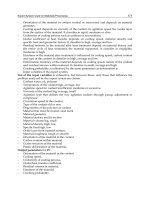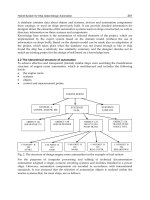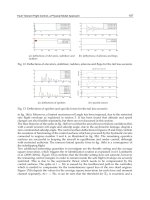Complex Robotic Systems - Pasquale Chiacchio & Stefano Chiaverini (Eds) Part 7 doc
Bạn đang xem bản rút gọn của tài liệu. Xem và tải ngay bản đầy đủ của tài liệu tại đây (738.53 KB, 15 trang )
3.3. Differential kinematics 83
The relative orientation between the two end effectors can be defined
with reference to the end-effector frame of either manipulator say the
first one in terms of the rotation matrix
= (3.4)
To simplify specification of some coordination task, it might be appro-
priate to choose pb and R~ other than the actual end-effector position and
orientation of the two manipulators. This results in embedding proper
constant transformation matrices in the direct kinematics of the two ma-
nipulators.
To be independent of the absolute motion of the system, it might be
more convenient to specify the relative position with reference to the abso-
lute frame, i.e., pa. The relationship between pr a and pb is given by
: R p: (3.5)
with R b as in (3.2).
A feature of the proposed formulation is that coordinated motion of the
system is achieved without necessarily assuming that the two manipulators
are kinematically constrained through the presence of an object between
the two end effectors. Nevertheless, if the two end effectors hold a common
object, general manipulation tasks can be described by the above formula-
tion. For instance, if the task is to move a tightly grasped object without
deforming it, a trajectory has to be assigned to pb a and Rba while pr a and R~r
have to be kept constant. Yet, if the task is to stretch, bend or shear the
object, suitable trajectories have to be specified for the relative variables
too.
3.3 Differential kinematics
Having established a task formulation for the direct kinematics of the two-
manipulator system, it is useful to derive also the differential kinematics
relating the coordinated (absolute and relative) velocities to the end-effector
velocities of the two manipulators.
For each manipulator, the end-effector linear velocity is directly given
as the time derivative of the position vector, that is lb b. The end-effector
angular velocity is given by the (3 x 1) vector w b, which is related to the
time derivative of the rotation matrix//b through the relationship
• b b b
R i = S(oai)Ri,
(3.6)
84 Chapter 3. Kinematic control of dual-arm systems
where S(.) is the (3 x 3) skew-symmetric operator performing the cross
product.
The absolute linear velocity of the system is obtained as the time deriva-
tive of (3.1), i.e.,
• b 1 b
P~
= 2(Pl .~_ pb).
(3.7)
Differentiating (3.2) with respect to time, using (3.6) and the relationship [6]
R~ S(~.~2)(R~) T :
S(R~2), (3.8)
yields
b b S({~d~)nb 1 b b
s( )Ro = + (3.9)
where w~2 denotes the angular velocity of frame 2 with respect to frame 1.
From (3.9) it can be recognized that the absolute angular velocity is
given by
b
!(~ q- wb), (3.10)
~a 2
since wb2 = W b W b.
The relative linear velocity of the system is obtained as the time deriva-
tive of (3.3), i.e.,
pb r (3.11)
If the relative position is expressed as p~, the time derivative of (3.5)
gives
= R~p~ + S(w~)p~ (3.12)
b
with w~ as in (3.10).
Finally, differentiating (3.4) with respect to time and using (3.6) yields
1 1
S(w,.)R~
=
S(w~2)tl ~,
(3.13)
and thus the relative angular velocity is
b = wb W~,
~r
(3.14)
which has been expressed in the base frame.
Algorithmic solutions to the inverse kinematics problem are based on the
computation of the Jacobian associated with the task variables of interest.
Since these variables have been expressed as a function of the position and
orientation of the two end effectors, the sought Jacobian can be related to
the Jacobians of the single manipulators.
Let ni denote the number of joints of manipulator i and qi be the (hi x 1)
vector of its joint variables. The geometric Jacobian J~(qi) is the (6 × n~)
3.4. Inverse kinematics algorithm 85
matrix relating the joint velocity vectors//i to the linear and angular end-
effector velocities in the base frame as
~ g~(q~)q~
i
At this point, combining (3.7),(3.10) and taking into account (3.15)
yields
,:] ( 10)
where the (6 x (nl + n2)) absolute Jacobian matrix is defined as
gb 1 b 1 b
[~J1 ]" ~J2
(3.17)
Further, combining (3.11),(3.14) and taking into account (3.15) yields
where the (6 x (nl + n2)) relative Jacobian matrix is defined as
J~ = [-J~ J~]. (3.19)
3.4 Inverse kinematics algorithm
The inverse kinematics problem for a two-manipulator system can be stated
as that to compute the joint variable trajectories corresponding to given co-
ordinated motion trajectories for the absolute and relative task variables.
Finding closed-form solutions is possible only for special manipulator ge-
ometries and simple coordination tasks, and thus an algorithmic approach
shall be pursued.
An effective inverse kinematics algorithm is given by the closed-loop
scheme based on the computation of the pseudoinverse of the manipulator
Jacobian [7,8]. The joint velocity solution can be written in the general
form
= 3f(Od + R~) + (I 3t3)~o, (3.20)
where ~/is a vector of joint variables, ) is the Jacobian associated with the
velocity mapping, Od is the desired task velocity, zV¢ is a suitable diagonal
positive gain matrix, ~ is the algorithmic error between the desired and
current task variables, and ~0 is a vector of joint velocities that can be
freely chosen.
86
Chapter 3. Kinematic control of duat-arm systems
Notice that the physical robot system is not involved since the algorithm
only serves the purpose to invert the kinematics of the system along a given
task trajectory, i.e., ~ is given by (3.20), and ~/is computed by integrating
the obtained ~.
The closed-loop inverse kinematics algorithm based on (3.20) avoids the
typical numerical drift of open-loop resolved-rate schemes [9]. The solution
can be made robust with respect to singularities of J by resorting to a
damped least-squares inverse of the matrix [10,11].
When J is square and full rank the pseudoinverse in (3.20) reduces to the
inverse and the second term on the r.h.s, vanishes. If J has more columns
than rows the system is
kinematically redundant;
in this case, the joint
velocity vector ~0 can be suitably chosen to meet additional constraints
besides the primary task. This is made possible since the term (I- JlJ) is
a projector onto the null space of J and thus the second term on the r.h.s.
of (3.20) allows reconfiguration of the system without affecting the primary
task [12].
It should be pointed out that kinematic redundancy of two-manipulator
systems may be due either to the effective presence of additional joint vari-
ables i.e., more than 6 degrees of freedom for either manipulator or to
relaxation of some coordination task variables. In [5] it has been show that
non-tight grasps can be treated as a special case of kinematic redundancy.
The above algorithm can be applied to solve the inverse kinematics for
the two-manipulator system at issue. In detail, define
The task Jacobian is
ql ]. (3.21)
q= q2
[ ] (3.22)
J= [j j,
where jb jb r are given as in (3.17),(3.19). The error is
~ = [ ea l
(3.23)
The
absolute error
has a position and an orientation component and is
given by
[ ]
- P° (3.24)
ea
~ 1 b b b b
+ S(so)s d +
~(S(na)nad s(aba)a
where
pb d
is the desired absolute position specified by the user in the base
frame, pb is the actual absolute position that can be computed as in (3.1),
nb ob .~b
ad, oad, "*ad are
the column vectors of the rotation matrix Rbad giving the
3.5. Cooperative system modeling 87
desired absolute orientation specified by the user in the base frame, and
nb b b
sa, a a are the column vectors of the rotation matrix Rba in (3.2). The
relative error is given by
~P~ - P~ (3.25)
er = 1 b 1 1 1 I 1 1 "
~R1(S(nr)nrd + S(Sr)Srd q- S(ar)ard )
The rotation R b is aimed at expressing the desired relative position P~d,
assigned by the user in the absolute frame, in the base frame; in this way, the
specification of the desired relative position between the two end effectors
is not affected by the absolute frame orientation. Further, in (3.25) notice
that: pr b can be computed as in (3.3); 1 1 1
Tgrd ~ 8rd ~
ard are the column vectors
of the rotation matrix Rlrd giving the desired relative orientation specified
by the user in the end-effector frame of the first manipulator; _1,%, ~r,~l t%-1 are
the column vectors of the rotation matrix Rlr in (3.4); and the rotation R b
is aimed at expressing the orientation error in the base frame.
Finally, the desired velocity is
~ = [V°d]. (3.26)
[ V~d J
The absolute velocity term is given by
[ ] (3.27)
• [o Idj '
where "b b
Pad and Wad are respectively the desired absolute linear and angular
velocities specified by the user in the base frame. The relative velocity term
is given by
b.a b b a
RaPrd + S(O;a)RaPrd ]
Vrd :
j (3.28)
where lb~d is the desired relative linear velocity specified by the user in the
object frame and wld is the desired relative angular velocity specified by
the user in the end-effector frame of the first manipulator. Notice that
the expression of the translational part of the relative velocity presents
an additional term which is a consequence of having assigned the relative
position with reference to the absolute frame.
3.5 Cooperative system modeling
The dynamics of the two manipulators can be written in compact form as
M(q)il + C(q, it)q + g(q) = r - jT (q)h, (3.29)
88
Chapter 3. Kinematic control of dual-arm systems
where the matrices are block-diagonal, e.g., M = blockdiag{M1, M2}, and
the vectors are stacked, e.g., g = [gT get IT. For each manipulator, ~'i is
the vector of joint generalized forces, Mi is the symmetric positive-definite
inertia matrix, Ci//i is the vector of Coriolis and centrifugal generalized
forces, gi is the vector of gravitational generalized forces, and hi is the
vector of end-effector generalized forces.
The dynamics of the object is given by
Moi~o + Covo + 9o = hezt,
(3.30)
where
Vo
is the vector expressing the (linear and angular) velocity of a
frame Eo attached to the center of mass of the object,
Mo
is the object
inertia matrix,
Covo
is the vector of Coriolis and centrifugal forces,
go
is
the vector of gravitational forces, and hext is the vector of external forces
acting at the center of mass of the object.
Under the assumption that the two manipulators tightly grasp a rigid
object, holonomic constraints on both joint positions and velocities arise,
e.g., see [13]. From a kinetostatic point of view, these constraints result in
suitable mappings involving forces and velocities at the object level.
The mapping of the contact force vector h onto the external force vector
hext
is [4]
[ I 0 I O] h= Wh,
(3.31)
h~xt = $1 I $2
where W is the grasp matrix, S1 and S2 are the matrices which transform
the applied contact forces in moments at the object frame and depend on
the grasp geometry, and I, O are the identity and null matrices of proper
dimension, respectively.
The matrix W has full row rank; then, for a given
h~xt,
the inverse
solution to (3.31) is given by
:Ew,
L hint J L hint
'
where W t denotes a pseudoinverse of W, V is a full-column-rank matrix
spanning the null space of W, and the vector
hint
represents the internal
forces [14]. Notice that the following relation holds
WV
= O. (3.33)
It has been recognized that the use in (3.32) of a generic pseudoinverse,
e.g., the Moore-Penrose pseudoinverse, may lead to internal stresses even if
3.6. Joint
space
control
89
hint
= 0; to avoid this, W t must be properly chosen [15]. In the remainder,
it is assumed that the pseudoinverse of W has the following expression
½i
wt = -½sl
½i
-½S2
(3.34)
As pointed out in [15], this choice is also motivated by the work in [16] since
it avoids problems with numeric solutions being noninvariant with respect
to changes of scale or origin.
One possible choice for the matrix V is [14]
I i]
v = . (3.35)
L-S2
In view of the duality between forces and velocities coming from the
principle of virtual work, it can be recognized that
where vr is the relative velocity dual to
hint
and v is the vector of end-
effector velocities. Notice that tight grasp of a rigid object results in vr = 0,
i.e.,
vWjit
= 0. (3.37)
3.6 Joint space control
The second stage of a kinematic control scheme for cooperative manipula-
tors requires the development of a joint-space control law. In this case, it
is assumed that reference joint trajectories performing a cooperative task
are available through proper inverse kinematics.
First, a classical PD-type control taw is considered; compensation of the
gravity term is used in order to avoid steady-state errors. The control law
for the system (3.29), (3.30), (3.32), is [17]
r = Kp(t - Kdq + g + jWwtg o
(3.38)
where
E1 = qd
q
is the error between desired and actual joint positions; Kp
and
Kd
are diagonal positive definite gain matrices of proper dimensions.
90
Chapter 3. Kinematic control
of dua/-arm
systems
It has been shown in [17] that for a given set point qd, the equilibrium
(q = O, it = O) of the system (3.29), (3.30), (3.32), under the control
law (3.38) satisfies the condition
Kp~lss JWVhint,ss
= 0 (3.39)
which reveals that at steady state an internal force is present if a joint error
exists. Such an error may be due to inconsistency of the joint set point with
the geometry of the grasp, that is, achievement of the joint set point would
require violation Of closed-chain constraints.
To avoid building of the internal force at steady state, a kineto-static
filtering of the joint errors has been proposed which retains the simplicity
of the above PD-type control law [18].
If the error term Kp~/ is regarded as an elastic torque acting at the
joints, it can be first transformed into the corresponding force at the two
end effectors through j-T, and then into an external force acting on the
object through W. In this way, the part of the error term which builds
internal force is filtered out. Thus, the control torque actually acting at the
joints can be compute " ~ the image of the required external force. The
proposed control law
r = JTwtwJ-TKp?1 Kdit + g + JTWtg o
(3.40)
where it is assumed that the Jacobian matrix J is square (nl + na = 2m)
and full rank.
The equilibrium of the system (3.29), (3.30), (3.32), under the control
law (3.40) satisfies
JTWtwJ-T Kpqss - JTVhint,ss
= O. (3.41)
Since jW is full column rank, it can be factored out and eq. (3.41) can be
rewritten as
WtWj-W KpClss - Yhint,ss
= 0. (3.42)
To analyze the equilibrium obtained, it is useful to observe that V spans
the null space of W while W t spans the range space of wT; therefore,
the two terms in the left-hand-side of (3.42) ave orthogonal and thus they
must be each equal to zero. Moreover, since W t and V are full column
rank matrices, it can be concluded that at steady state it is
( wj-T Kp~tss = 0
(3.43)
hint,ss = 0
3.7. Stability analysis
91
Remarkably, the former condition implies that the component of the joint
error term in the external-force space vanishes, the latter ensures that the
internal force is null at steady state.
Therefore, the control law (3.40) cancels internal force at steady state,
even if the joint set point cannot be reached due to closed-chain constraints.
It is worth noting that the kineto-static filtering has no effect on steady-
state errors due to external disturbances and thus the control law (3.40)
reacts to them at full strength.
Equation (3.43) represents a set of constraints on the vector variable qss.
The nonlinearity of the constraint equations does not allow drawing general
conclusions about the solution of (3.43); physical reasoning, however, leads
to conjecturing that a set of solution points exists, corresponding to different
system equilibrium configurations.
3.7 Stability analysis
La Salle's global invariant set theorem as reported in [19] is invoked to
analyze the stability of the equilibrium (3.43) [20-21].
Consider the scalar function with continuous first partial derivatives
1T 1T ~
Y(x) = I ~ITMcl + -~v o Movo + 5~1 Kpq,
(3.44)
where x
= [oT aT IT
belongs to the subspace • C IR 24 constituted by the
joint errors and velocities satisfying the closed-chain constraints. Notice
that V in (3.44) is radially unbounded.
Under the assumption of a constant
qd
(i.e., regulation problem), by
using (3.29) and (3.30), the time derivative of (3.44) is
W h
V(x) = qT (v
jWh - g) + v o ( ezt - go) elTKpgl,
(3.45)
where the identities ~/T(M - 2C)q 0,
vT(Mo 2Co)vo = 0
have been
exploited.
By expressing
vo as
in (3.36) and taking (3.32) into account, equa-
tion (3.45) can be rewritten as
V(x) = qW (r jwVh,,~t - g - JWWt9o Kpcl).
(3.46)
Considering the closed-chain constraint (3.37) and substituting control
law (3.40) into (3.46) yields
y(~) = _qTKd ~ _
qTjT(I
WtW)j-TKp~I.
(3.47)
92
Chapter 3. Kinematic control of dual-arm systems
It can be recognized that the second term on the right-hand side of (3.47)
is null in view of the closed-chain constraint (3.37); in fact, the term
(I - WtW)Jil is a vector of end-effector velocities which correspond
through (3.36) to sole relative velocities. At this point, equation (3.47)
becomes
? (x) = clT K dcl (3.48)
which is negative semi-definite all over ~.
The set R of all points x E • where V(x) = 0 is then
R={xe~: //=0}. (3.49)
Following the analysis of the equilibrium in the previous Section, it can be
recognized that the largest invariant set in R is
M = {x E R: ~,, satisfies (3.43)}. (3.50)
Therefore, the global invariant set theorem ensures global asymptotic con-
vergence to M.
Notice that, according to the assumption on J being full-rank, the result
is valid for any perturbation such that the resulting trajectory does not
involve crossing of kinematic singularities of the two-manipulator system.
In the case when the set M contains the origin, i.e., when the given set
point can be achieved without violating the closed-chain constraints, it is
worth studying the domain of attraction of x = 0. Since V(x) in (3.44) is
quadratic, it is always possible to find a positive ~ and a bounded region
~t C (I, such that ¢I't N M = {0} and
V(x) < ~ Vx e Or. (3.51)
y(x) < o
By applying the local invariant set theorem, it can be recognized that Ot
is a domain of attraction for the equilibrium point x = 0.
When the set M does not contain the origin, the given set point cannot
be achieved without violating the closed chain constraints. In this case,
it becomes worth studying local stability of the minimum-norm element(s)
in M; to the purpose, by following the same reasoning as above, the local
invariant set theorem can be invoked to establish the existence of a domain
of attraction.
3.7.1 Imperfect compensation of gravity terms
In many practical cases the mass of the object is not accurately known;
thus, only a nominal estimate of the gravity term go is available. In this
3.7. Stability analysis
93
case the control law (3.40) becomes
T = JTw~wJ-TKp~I gdi t + g + JTW~go.
(3.52)
The equilibria of the system (3.29), (3.30) and (3.32) under the control
law (3.52) satisfy
{ wj-Wgpqss = go - ~1o
(3.53)
hint,ss -= 0
Inaccurate compensation of the object gravity term leads to a set of equi-
librium configurations which are different from those obtained via (3.43).
Nevertheless, the internal forces are still null at steady state.
Stability of the equilibrium (3.53) can be analyzed following the guide-
lines in [22]. To the purpose, consider the gravity energy functions
Uo(q)
and
Uo(q)
such that
OUo(q)
- gTwtg o
(3.54)
Oq
O~7o(q)
jTW~Oo
(3.55)
Oq
Notice that both
Uo(q)
and
Uo(q)
are bounded for any q.
At this point, consider the scalar function with continuous first partial
derivatives
Vo(x) = 2 qT Mil + lvW + l ~tW + Uo(q) -
Uo(q), (3.56)
which is obtained by suitably extending the scalar function V in (3.44).
Again, x belongs to the subspace (~ constituted by the joint errors and
velocities satisfying the closed-chain constraints. Notice that Vo is radially
unbounded in view of radial unboundedness of V and boundedness of the
gravity energy functions.
Taking into account (3.54,3.55), it can be easily recognized that
"Co(X) = ~lT Kdil,
(3.57)
which is negative semi-definite all over ~. Thus, the global invariant set
theorem can be invoked to conclude asymptotic convergence of x to the
invariant set
Mo = {x E R: ~ satisfies (3.53)}. (3.58)
In the case of imperfect compensation of the manipulators' gravity term
the same argument as above leads to recognize asymptotic stability of the
equilibrium
{ wg-W gp~lss = wg-W(g - ~)
(3.59)
Vhint,~ = j-T (g _ ~1)
94
Chapter 3. Kinematic control of dual-arm systems
where 0 denotes the available estimate of g. It must be pointed out that in
this case the equilibrium does not yield null internal force at steady state.
3.8 Addition of a force loop
The proposed control law (3.40) achieves the equilibrium with null internal
force. If it is desired to impose a given internal force set point, force feedback
should be added.
For a cooperative manipulator system, end-effector force measurements
are typically available through wrist sensors. To extract internal forces
from h, multiplication of (3.32) by V t gives
hint =
Vt h.
(3.60)
At this point, the control law (3.40) can be modified into
"r : JTwtwj-T Kp(I - gd(:l + g + jWWtgo
+JTV(hi,~t,~ + Ki(hi,~t,d - Vth)),
(3.61)
where K I is a positive definite matrix gain and
h~nt,d
is the desired internal
force set point.
For a given set point
qd,
the equilibrium of system (3.29), (3.30), and
(3.32) under control law (3.61) satisfies
JTw~wJ-T Kp(lss + JTv(I + KI)(hlnt,d - hint,ss)
= 0 (3.62)
which can be rewritten as
f wj-Wgp(lss = 0
(3,63)
hint,ss = hint,d.
TO analyze stability of equilibrium (3.63), consider the same scalar func-
tion V(x) as in (3.44). It can be recognized that the time derivative of (3.44)
along the system trajectory is the same as in (3.48); indeed, by substituting
control law (3.61) into (3A6), the force feedback terms do not contribute
to I?(x) in view of the closed-chain constraint (3.37).
The same argument as in Section 3.7 leads to establishing global asymp-
totic convergence to the set
M'
= {x E R: ~ satisfies (3.63)) (3.64)
and local asymptotic stability of the minimum-norm element(s) in M'. Fur-
ther, the same argument as in Subsection 3.7.1 can be used to analyze the
case of imperfect compensation of the gravity terms.
3.9. Conclusions
95
3.9 Conclusions
A kinematic control approach for cooperative manipulator systems has been
described. A useful feature of the chosen approach is that coordination is
solved at inverse kinematics level while arm interactions are handled at
joint control level. A set of meaningful variables has been defined to fully
describe coordinated motion tasks in terms of absolute/relative position
and orientation. An inverse kinematics algorithm has been presented whose
outputs are the joint reference variables to be fed to joint-space controllers.
In order to avoid building of internal forces kinetostatic filtering of the joint-
space errors is adopted. Addition of a force control loop is also discussed.
Stability analysis has been provided for the equilibrium points of the
cooperative system under the proposed joint-space control laws. The anal-
ysis has been extended to the case of imperfect compensation of the gravity
terms.
Application of the above control strategy to a setup of two industrial
manipulators is ongoing. Preliminary experimental results are reported
in [23].
Acknowledgments
This work has been partly supported by Ministero dell'Universit~ e della
Ricerca Scientifica e Tecnologica under 60% and 40% funds.
References
[1]
Y. Nakamura, K. Nagai, and T. Yoshikawa, "Mechanics of coordi-
native manipulation by multiple robotic mechanisms,"
Proc. 1987
IEEE Int. Conf. on Robotics and Automation,
Raleigh, NC, 991-
998, 1987.
[2]
Z. Li, P. Hsu, and S. Sastry, "Grasping and coordinated manipula-
tion by a multifingered robot hand,"
Int. J. of Robotics Research,
8(4), 33-50, 1989.
[3]
P. Dauchez,
Descriptions de tdches en rue de la commande hybride
symdtrique d'un robot manipulateur a deux bras,
Th~se d'Etat, Uni-
versit~ des Sciences et Techniques du Languedoc, Montpellier, F,
1990.
96
[4]
[5]
[6]
[7]
[8]
[9]
[lO]
[11]
[12]
[13]
[14]
Chapter 3. Kinematic control of dual-arm systems
M. Uchiyama and P. Dauchez, "Symmetric kinematic formulation
and non-master/slave coordinated control of two-arm robots," Ad-
vanced Robotics, 7, 361-383, 1993.
P. Chiacchio, S. Chiaverini, and B. Siciliano, "Direct and inverse
kinematics for coordinated motion tasks of a two-manipulator sys-
tem," Trans. ASME Y. of Dynamic Systems, Measurement, and
Control, 118,691-697, 1996.
L. Sciavicco and B. Siciliano, Modeling and control of robot manip-
ulators, McGraw-Hill, New York, 1996.
B. Siciliano, "A closed-loop inverse kinematic scheme for on-line
joint-based robot control," Robotica, 8, 231-243, 1990.
P. Chiacchio, S. Chiaverini, L. Sciavicco, and B. Siciliano, "Closed-
loop inverse kinematics schemes for constrained redundant manip-
ulators with task space augmentation and task priority strategy,"
Int. J. of Robotics Research, 10, 410-425, 1991.
A. Balestrino, G. De Maria, L. Sciavicco, "Robust control of robotic
manipulators," Prep. 9th IFAC World Congress, Budapest, H, 6,
80-85, 1984.
Y. Nakamura and H. Hanafusa, "Inverse kinematic solution with
singularity robustness for robot manipulator control," Trans.
ASME J. o] Dynamic Systems, Measurements, and Control, 108,
163-171, 1986.
C.W. Wampler, "Manipulator inverse kinematic solutions based
on vector formulations and damped least-squares methods," IEEE
Trans. on Systems, Man, and Cybernetics, 16, 93-101, 1986.
Y. Nakamura, H. Hanafusa, and T. Yoshikawa, "Task-priority based
redundancy control of robot manipulators,"
Int. J. of Robotics Re-
search, 6(2), 3-15, 1987.
J.Y.S. Luh and Y.F. Zheng, "Constrained relations between two
coordinated industrial robots for motion control," Int. J. of Robotics
Research, 6(3), 60-70, 1987.
P. Chiacchio, S. Chiaverini, L. Sciavicco, and B. Siciliano, "Global
task space manipulability ellipsoids for multiple arm systems,"
IEEE Trans. on Robotics and Automation, 7, 678-685, 1991.
REFERENCES 97
[15] I.D. Walker, R.A. Freeman, and S.I. Marcus, "Analysis of motion
and internal loading of objects grasped by multiple cooperating ma-
nipulators," Int. J. of Robotics Research, 10, 396-409, 1991.
[16] H. Lipkin and J. Duffy, "Hybrid twist and wrench control for a
robotic manipulator," Trans. ASME J. of Mechanisms, Transmis-
sions, and Automation in Design, 110, 138-144, 1988.
[17] J.T. Wen and K. Kreutz, "Motion and force control of multiple
robotic manipulators," Automatica, 28, 729-743, 1992.
[18] P. Chiacchio and S. Chiaverini, "PD-type control schemes for co-
operative manipulator systems," Int. J. of Intelligent Automation
and Soft Computing, 2, 65-72, 1996.
[19] J J.E. Slotine and W. Li, Applied nonlinear control, Prentice-Hall,
Englewood Cliffs, N J, 1991.
[20] F. Caccavale, P. Chiacchio and S. Chiaverini, "Stability analysis of
a joint space control law for a two-manipulator system," Proc. 35th
Conf. on Decision and Control, Kobe, J, 3008-3013, 1996.
[21] F. Caccavale, P. Chiacchio and S. Chiaverini, "Stability analysis
of a joint space control law for a two-manipulator system," IEEE
Trans. on Automatic Control, to appear, 1997.
[22] P. Tomei, "Adaptive PD controller for robot manipulators," IEEE
Transactions on Robotics and Automation, vol. 7, no. 4, pp. 565
570, 1991.
[23] F. Caccavale, P. Chiacchio, S. Chiaverini, B. Siciliano, "Experi-
ments of kinematic control on a two-robot system," Prep. 11th
CISM-IFToMM Symposium on theory and Practice of Robot Ma-
nipulators, Udine, I, 1996.









